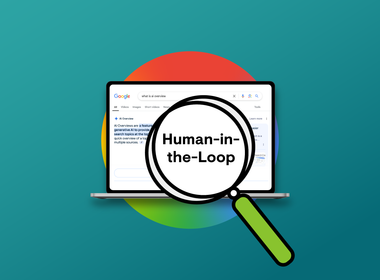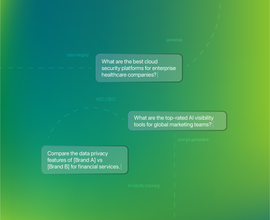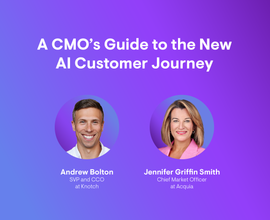What is a Human-in-the-Loop Approach to Leveraging AI?
AI is completely transforming how businesses operate, from automating routine tasks to generating complex content and analyzing vast datasets. As AI systems become more sophisticated, they come with a critical question: How do we ensure these powerful tools enhance human decision-making and ethical standards, instead of compromising them? The answer is implementing a human-in-the-loop (HITL) approach to AI.
Striking a balance between AI and human expertise is essential for enterprise organizations navigating the complexities of AI adoption, ensuring accuracy, mitigating risks, and fostering trust in AI-driven outcomes.
What is a human-in-the-loop (HITL) approach to AI?
At its core, human-in-the-loop (HITL) refers to a process where human expertise is integrated into a machine learning (ML) or AI system's workflow. This means humans actively participate in the feedback loop, training, validation, or correction of AI models. The goal is to continuously improve the AI's performance, accuracy, and reliability by leveraging human expertise.
Common examples of a HITL approach span industries. In content creation, humans review AI-generated drafts for factual accuracy, brand voice adherence, and overall quality. In medical diagnosis, AI might flag potential issues, but a human doctor makes the final diagnosis. AI identifies suspicious patterns for financial fraud detection, but human analysts confirm fraudulent activity. Even in SEO and content optimization, human expertise is vital for refining AI-driven recommendations and ensuring content truly resonates with an audience.
Why is a human-in-the-loop approach important?
HITL is particularly valuable in scenarios where the stakes are high. This includes situations that require high accuracy, ethical considerations, or a nuanced understanding that goes beyond what an algorithm can provide.
At the end of the day, an AI is still going to write something that doesn't have that next level of expertise, wisdom, and authorship that takes something from an A to an A+ piece of content.
Think about generative AI, like ChatGPT or Gemini . They can produce vast amounts of text, images, or code. While incredibly efficient, the outputs often require human review to ensure factual accuracy, eliminate bias, maintain brand compliance, and refine for tone and style. Without human oversight, AI-generated content could inadvertently spread misinformation or misrepresent a brand, and it’s unlikely it will be mentioned or cited in search.
If you want to leverage AI, you need the ability to intercept errors and issues. You need guardrails, like a content score, for instance.
In high-risk AI systems, such as those used in healthcare, finance, legal services, or autonomous vehicles, human involvement is not just beneficial but often mandatory. For example:
- Healthcare: AI might assist in analyzing medical images, but a radiologist's human judgment is crucial for a definitive diagnosis.
- Legal: AI can sift through legal documents, yet human lawyers interpret complex laws and make strategic decisions.
- Financial services: AI identifies suspicious transactions, but human analysts investigate and confirm fraud, preventing false positives that could impact customer trust.
HITL isn’t about replacing humans with AI, but about augmenting human capabilities and ensuring that AI systems operate within defined parameters of accuracy, ethics, and accountability. It is about making AI a powerful assistant, not an unchecked authority.
The risks of not implementing a human-in-the-loop approach
While the benefits of HITL are clear, striking the right balance between automation and human insight presents its own set of challenges. Organizations must proactively address potential pitfalls to ensure AI systems are effective, ethical, and trustworthy.
Leveraging AI comes with inherent risks around accuracy, bias, and trust, which is why human oversight is so important.
- Accuracy: Even the most advanced AI models can make mistakes sometimes and provide inaccurate information. Incorrect information will harm your authority and expertise, and depending on your industry and the content, could leave your brand exposed to compliance or legal risks.
- Bias: AI systems learn from the data they are fed. If this training data contains historical biases, the AI will carry those on. This is called data bias. Biases within your content will erode your brand’s credibility and your audience’s trust. Once again, depending on the nature of the bias, it could also leave you at risk for legal or compliance concerns.
- Trust: Biases and inaccurate information will have a domino effect on your brand’s reputation and the audience’s trust. Relying too much on AI without human oversight can lead to a lack of confidence from users, stakeholders, and the public.
Another risk is automation bias. This is when humans over-rely on automated systems, even if there’s evidence disproving it. This can lead to complacency and a lack of critical thinking.
How to balance human and AI collaboration
While "human-in-the-loop" is often used as an umbrella term, it is helpful to distinguish between three primary models of human-AI interaction:
- Human-in-the-loop (HITL): In this model, humans are central to AI’s decision-making processes, often reviewing entire outputs or large samples, actively providing feedback, labeling data, validating AI decisions, or correcting errors to ensure quality.
- Human-on-the-loop (HOTL): Here, humans mostly monitor the AI system's performance and intervene only when necessary. The AI operates autonomously for the most part, like an AI agent, but humans are "on call" to address anomalies, errors, or situations where the AI's confidence level is low. This model works well in systems that are largely stable and reliable already, but still need a safety net.
- Human-in-command (HIC): In this model, humans keep ultimate decision-making authority, with AI serving as an advisory tool. The AI provides recommendations, insights, or analyses, but the final decision is with a human. Examples of this can be seen in strategic planning, medical diagnosis, or military operations, where human ethical judgment and accountability are non-negotiable.
I don't like the idea that human-in-the-loop is a pessimistic take on AI. Some people think: ‘I need a human in the loop because AI's not good enough.’ I think AI is going to get good enough. AI is going to get really good in many cases where humans won’t have to intercept AI errors. It will shift to you observing the AI and, more so, monitoring what it’s doing, like you would treat a colleague.
AI is meant to augment human intelligence, not replace it. Choosing the right model depends on factors like the complexity of the task, the potential impact errors would have, and the AI system itself.
How to implement a human-in-the-loop approach
To reduce AI risks, organizations need practical methods to monitor, audit, and calibrate their AI systems with human expertise.
Check out a few workflows and processes to implement a human-in-the-loop approach to AI.
- Test your AI: Schedule periodic reviews of AI outputs and decisions to pinpoint areas of improvement.
- Human-led QA: Implement a quality assurance process where human experts review samples of AI outputs.
- Establish clear human-AI collaboration metrics: Define KPIs that track the effectiveness of your HITL process. This could include metrics like human review time, error reduction rates, or the percentage of AI outputs requiring human correction.
- Calibrate your AI models: Use team feedback to continuously refine and adjust AI models to ensure the AI learns from human corrections and improves its performance over time.
- Transparency and explainability: Strive for AI systems that are as transparent as possible, allowing human operators to understand why an AI made a decision.
The importance of a unified approach to HITL
Like with any other workflow, it’s difficult to oversee a disjointed process that lives across multiple tools and point solutions. A human-in-the-loop approach works best when paired with an all-in-one AI visibility platform, like Conductor, that allows teams to measure, optimize, and monitor their visibility from one central location.
Trying to oversee your site’s entire visibility across point solutions that don’t communicate with one another leaves you exposed to missing critical issues and growth opportunities.
Human-in-the-loop in review
As AI systems become more and more popular, human-in-the-loop approaches to AI are essential. By balancing human oversight with AI, organizations can boost decision-making, reduce brand risks, and ensure ethical AI use.
It’s not about limiting AI. It’s about grounding it in human intelligence, empathy, and accountability. Embrace the power of human-AI collaboration to drive better accuracy, reduce bias, and build trust in your AI-driven processes.
FAQs
- What are content guardrails?
- How do you increase brand mentions and citations in AI?
- What is a knowledge cutoff?
- What are AI hallucinations?

![Patrick Reinhart, VP, Services and Thought Leadership, [object Object]](https://cdn.sanity.io/images/tkl0o0xu/production/9bc72298b24ad01b732de4c3376f79546d20f81c-3542x3542.png?fit=min&w=100&h=100&dpr=1&q=95)
![Wei Zheng, Chief Product Officer, [object Object]](https://cdn.sanity.io/images/tkl0o0xu/production/dcfa62c0fe34ba0c31f910b818874cd160ad8839-3542x3542.png?fit=min&w=100&h=100&dpr=1&q=95)






